There’s quite a few things i miss about Belgium. On top of the list are: eating grey shrimps in Ostende (especially when the sky is grey and the sea even greyer) and the ridiculously small amount of time it takes to be out of the country. Last week i sat 2 hours in a train and i was in Paris. A few days before that i took another train and after 30 minutes and hop! i was in Maastricht, a city which has a very powerful magnet for me: NAI Maastricht , the little sister of Netherlands Architecture Institute in Rotterdam.
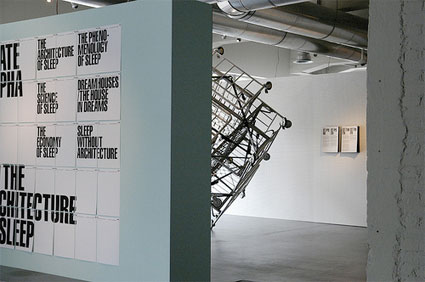 The entrance of the exhibition, with the sculpture of Peter Sandbichler. Photo Guus van den Akker. Image courtesy NAI Maastricht
The entrance of the exhibition, with the sculpture of Peter Sandbichler. Photo Guus van den Akker. Image courtesy NAI Maastricht
The ground floor of the institute was occupied by State Alpha, on the architecture of sleep, an exhibition that explored (it closed a couple of days ago) the theme of sleep as a psychological inner world, while drawing on such areas as film and product design to visualize the relation between architecture and that inner world.
That was a very satisfying exhibition. My mind kept feeling stimulated (not an easy task, believe me), the works selected were good, the archives fascinating, the information was shooting in all directions, the graphic design was stunning (congrats to Experimental Jetset) and there were beds all over the place to watch the videos and fall asleep on a quiet afternoon.
Different aspects of sleep were examined in six chapters.
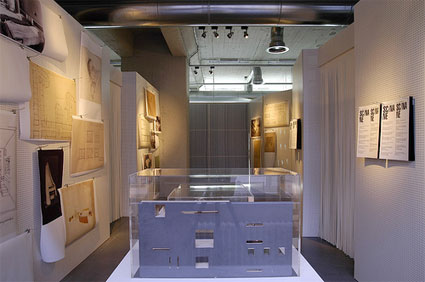 An impression of the archive of NAI on the subject ‘sleep’. Photo Guus van den Akker
An impression of the archive of NAI on the subject ‘sleep’. Photo Guus van den Akker
Image courtesy NAI Maastricht
Phenomenology of Sleep is a collection of film fragments that show the rituals of falling asleep and getting up within their architectural context.
The Architecture of Sleep, a medical expression that describes the structure of the sleep process, gave the lowdown on the current state of sleep research. On the other had, the chapter Science of Sleep compared how other (pseudo-scientific) expertises such as Feng Shui deal with sleep and its spatial effect on how we organize our bedrooms.
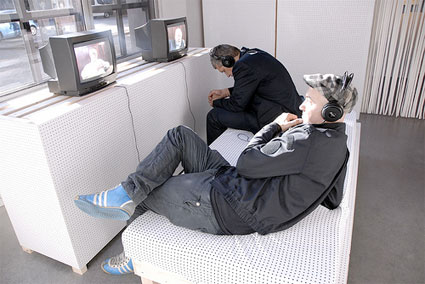 People listen to the visions on ‘the house in the dream’ of Lacan-experts Walter Seitter and August Ruhs. Photo Moniek Wegdam. Image courtesy NAI Maastricht
People listen to the visions on ‘the house in the dream’ of Lacan-experts Walter Seitter and August Ruhs. Photo Moniek Wegdam. Image courtesy NAI Maastricht
Dream House investigates the dream house within the housing market but also the house as a symbol in the subconscious.
The fifth chapter, Economy of Sleep, focuses on the opposition between sleep as a gift and source of vitality and sleep as a product around which an enormous market has developed – beds, scents, masks, creams, herbs, therapies, medicines…
The final chapter, Sleep without Architects, presents several examples that escape the clutches of architecture. By highlighting the position of the homeless and other ‘alternative’ ways of sleeping, this chapter raises the discussion on the role of architecture and the way in which it organizes sleep. This is the chapter i’m going to focus on.
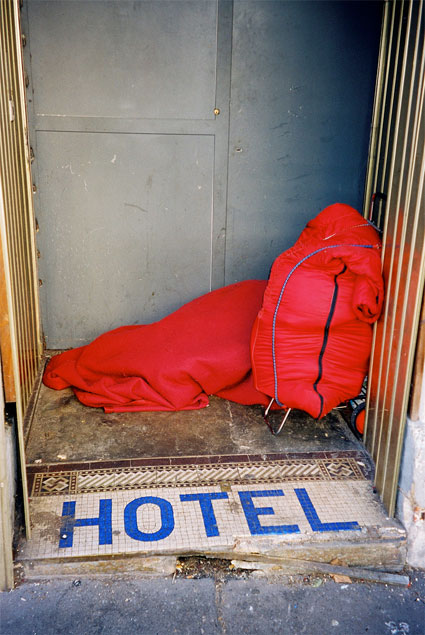 Parisian homeless (sans-abri), photographed by Bernhard Cella
Parisian homeless (sans-abri), photographed by Bernhard Cella
Providing a shelter for sleep is far from being the exclusive domain of architects. Austrian photographer Bernhard Cella shows us the Parisian sans-abri as amateur architects who arrange their sleeping place and deliberately reckon with the look of passers-by.
In the gallery was a video of Roman Signer’s 1992’s Action, Garenne Lemot, Clisson. The artist installed a tent in the middle of the park of La Garenne Lemot and he slept every night there for a week. Inside the tent was a microphone connected via an amplifier to powerful loudspeakers hung on trees in the nearby woods. Because Signer snores, the sound of hi snoring was played in full blast (and only at night) in the surrounding landscape.
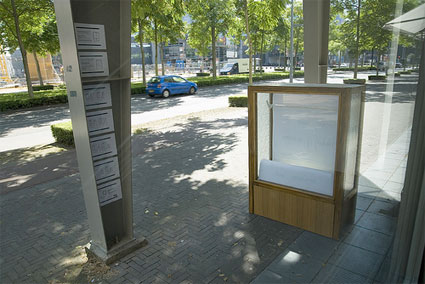
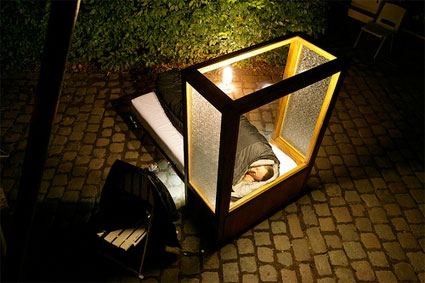 T.R.A.U.M., bedsculpture of Barbara Caveng, which can be used free of charge after advance reservation. Photo Mathias Schormann
T.R.A.U.M., bedsculpture of Barbara Caveng, which can be used free of charge after advance reservation. Photo Mathias Schormann
Barbara Caveng left the T.R.A.U.M. (‘dream’ in german) foldaway bed right in front of the NAI for people to take a nap there any time they wanted. All you had to do was make a reservation if you needed it on a particular day or night. Unfortunately the bed was destroyed during a Summer night.
The piece of furniture was originally a wall bed that the artist found in a Berlin road tunnel in 2004 and modified several times. The most important aspect of this piece is not the beauty of this glass encased bed sculpture. What matters is the gesture that comes with it, it is a social sculpture with a practical and generous use.
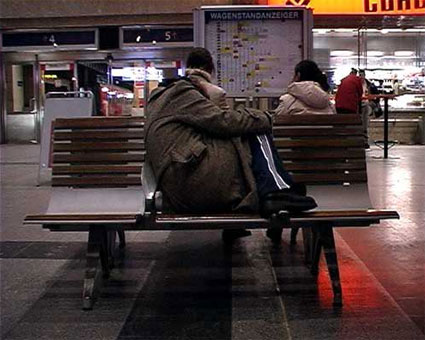
In her video Research for Sleeping Positions, Anna Jermolaewa experiments with a variety of possible sleeping positions on a bench of the type of a growing number of public benches constructed so as to prevent people lying down or sleeping. The bench she chose is located at Vienna’s Westbahnhof, the place where in 1989 Jermolaewa spent her first week as a refugee in the West. By designing public space furniture that discourage people from lingering there, city administration is also setting social mechanisms of exclusion.
The idea of a ‘natural’ nocturnal sleep is a naive one. Most cultures have adopted more than just night-time monophasic sleep. Think of the Mediterranean siesta, for example.
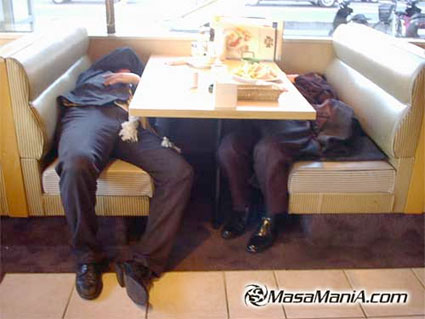
Japanologist Brigitte Steger researched a unique Japanese forn of multiphasic sleep that sees people responding to their need of sleep by taking a nap in full view of wakeful people and in public places. This peculiar behaviour is called Inemuri. Even in their sleep, people are supposed to behave according to rules of the social setting. The phenomenon makes it clear that sleep is organized more by social rules than by architectural measures.
The concept State Alpha, on the architecture of sleep has been developed by Liquid Frontiers. The exhibition design is by EventArchitectuur. The graphic design is by Experimental Jetset.
Here’s a slideshow of the images from the exhibition:
State Alpha, on the architecture of sleep is the first in a diptych. The second part will open at the end of October under the title Changing Ideals.
Previously at the NAI Maastricht: Edible City Part 1 and part 2.
Related: Conflux – Vertical Bed, Urban furniture to accommodate the homeless.
